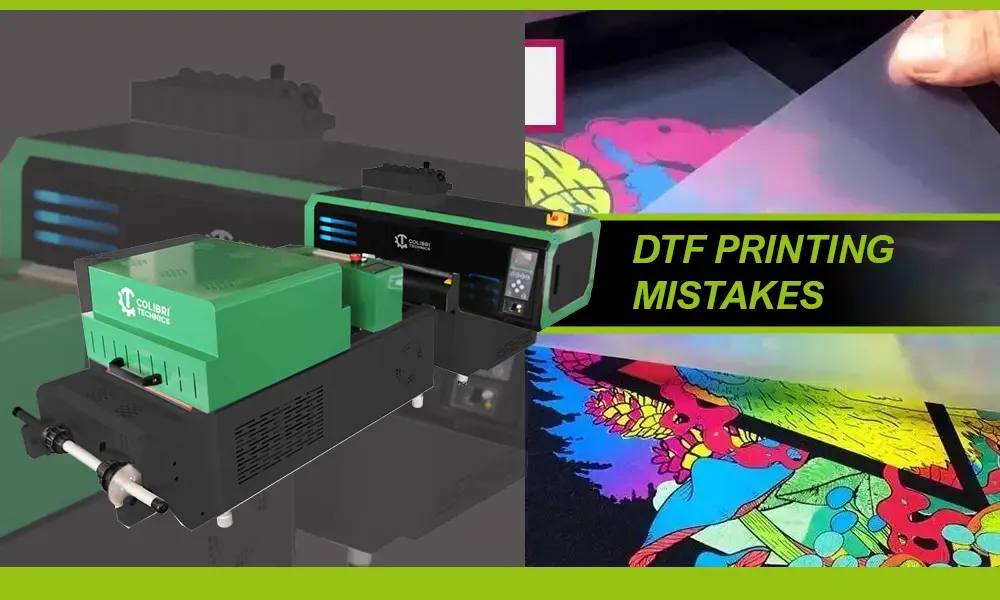DTF printing mistakes can often derail even the most vibrant and creative designs, leaving you with results that fall short of expectations. Whether you’re a beginner or a seasoned professional, there are common DTF printing errors that can be easily avoided with the right knowledge and preparation. In this guide, we will explore the best practices for DTF printing, focusing on how to improve DTF printing outcomes by eliminating these pitfalls. Understanding the nuances of DTF printing quality control will ensure you make informed choices, leading to stunning results on every garment. Join us as we highlight key tips that can elevate your DTF printing game and help you achieve the vibrant prints you’ve always dreamed of.
Direct to Film (DTF) printing presents an innovative method for transferring eye-catching graphics onto fabric, yet it comes with its own set of challenges. Many individuals encounter various issues related to DTF production, including common pitfalls that can hinder their results. Understanding how to avoid these mistakes is essential for optimizing your printing process and achieving professional results. This article delves into the intricacies of DTF processes and the critical considerations that influence successful transfers. From selecting the right materials to conducting diligent quality checks, we’re here to guide you on a smooth journey toward flawless DTF printing.
Understanding Common DTF Printing Errors
DTF printing offers a myriad of opportunities for creative expression, yet common errors can mar the final output. One prevalent issue relates to using incorrect film types. Selecting the wrong DTF transfer film can lead to inadequate ink adhesion, resulting in prints that may crack or peel off after washing. This problem is often overlooked by beginners who might assume that all transfer films are made equal. By familiarizing yourself with the characteristics of high-quality films, such as their ability to allow for vibrant, long-lasting prints, you can save yourself time and resources in the long run.
Moreover, another common DTF printing error arises from improper handling of color profiles. Artists frequently overlook this aspect, unintentionally leading to harsh discrepancies between what they see on their screens and the printed product. Implementing the correct color profiles set by the printer’s manufacturer ensures that the colors in your design are accurately represented, fostering a professional aesthetic in your prints. Understanding these fundamental aspects of DTF printing errors can immensely elevate your printing quality.
Essential DTF Printing Tips for Beginners
For those just starting in DTF printing, leveraging essential tips can enhance your overall productivity and print quality. First and foremost, ensure that you are using optimal ink and temperature settings tailored for the fabric in question. Polyester fabrics often require different heat application than cotton, causing beginners to mistakenly produce dull colors or failed transfers when using incorrect settings. By consulting the guidelines provided by your ink provider, you will be equipped with the knowledge to adjust your settings effectively.
Another vital tip for novices is to invest time in painstakingly prepping your garments. A clean, wrinkle-free surface is paramount for successful prints; dirt or moisture can undermine adhesion and spoil a beautiful design. Even a simple step such as pre-pressing the fabric can significantly increase print quality and durability. By following these critical tips, beginners can streamline their DTF printing process and avoid the frequent mistakes associated with haste.
Best Practices for DTF Printing Quality Control
Implementing best practices for quality control in DTF printing is essential for maintaining high printing standards. One fundamental principle involves conducting regular maintenance checks on your DTF printer. Neglecting tasks such as cleaning print heads and managing ink levels can lead to a decline in print quality over time. A well-maintained printer not only produces clearer and more consistent results, but it also extends the machine’s lifespan, ensuring that you can achieve stunning prints for years to come.
Additionally, it’s crucial to incorporate a thorough testing phase before proceeding to large production runs. This process allows you to identify and resolve any potential issues with settings or materials, mitigating the risk of costly errors later on. A test print helps ensure that everything from color accuracy to adhesion is up to par before committing to a full batch. By embedding these practices into your routine, you are setting yourself up for successful and reliable DTF printing outcomes.
How to Improve Your DTF Printing Results
Improving your DTF printing results can often be achieved by a few key adjustments in your process. A great starting point is to closely monitor your ink consumption and make certain you are using high-quality inks. Using inferior inks can lead to a lackluster finish, making your designs appear dull and prone to fading. Instead, opting for reputable ink brands that are compatible with your printer can significantly elevate your print quality and produce vibrant, eye-catching designs.
Alongside ink selection, focusing on your drying and curing time is another method to enhance your DTF printing results. Many users tend to rush through this process, failing to give inks sufficient time to set. This can result in smudged prints and poor quality. By allowing adequate drying time between layers—or between the print stage and the heat press—you can achieve more stable prints that last longer and maintain their vibrancy even after multiple washes.
Developing a Quality DTF Printing Workflow
Building an efficient workflow is crucial for successful DTF printing. Integrated planning, from design conception to the final ironing phase, ensures that each component works harmoniously together. Start by outlining your design specifications and materials, ensuring that every element aligns with your printing capabilities. This thorough preparation reduces wasted materials and aligns your creative vision with practical execution.
Subsequently, focus on streamlining your printing process by organizing your workspace effectively. Keeping all tools, inks, and materials readily accessible and well-categorized can dramatically improve both speed and accuracy. An organized setting allows for more focused attention on printing techniques and quality assurance, which enhances your overall DTF printing experience and results.
Final Thoughts on Avoiding DTF Printing Mistakes
As you delve further into the world of DTF printing, understanding the common pitfalls and actively taking steps to avoid them can lead to impressive results. Avoiding mistakes like poor-quality film selection or improper garment preparation can go a long way in ensuring successful prints. By prioritizing the right materials and setting appropriate standards for quality control, you’ll not only enhance print quality but also establish credibility in your printing business.
Finally, remember that meticulousness in every step of the DTF printing process—from testing to maintenance—will yield the best outcomes. Emphasizing the importance of attention to detail and patience will result in prints that meet or surpass expectations. Ultimately, embracing best practices in DTF printing ensures that your creations resonate with customers and showcase your artistic prowess.
Frequently Asked Questions
What are the most common DTF printing mistakes to avoid for better results?
The most common DTF printing mistakes include using poor quality films, failing to prep the garment properly, and neglecting ink settings. To avoid these errors, always choose high-quality transfer films, ensure garments are clean and dry, and adjust your ink settings according to the fabric type.
How can I improve DTF printing quality by avoiding common mistakes?
To improve DTF printing quality, focus on avoiding mistakes such as ignoring color profiles, neglecting printer maintenance, and rushing the printing process. By ensuring you use the correct color profiles, keeping your printer well-maintained, and taking your time during printing, you can enhance the overall outcome.
What DTF printing tips can help prevent production issues?
Key DTF printing tips include conducting test prints, preparing garments correctly, and selecting the appropriate inks for your substrates. By consistently applying these best practices, you can prevent common DTF printing mistakes and achieve the desired print quality.
What best practices should I follow to avoid DTF printing mistakes?
Best practices for DTF printing include using high-quality materials, pre-pressing garments, ensuring proper ink settings, and performing regular printer maintenance. Following these steps will minimize errors and enhance the overall print quality.
How does proper garment preparation affect DTF printing outcomes?
Proper garment preparation significantly affects DTF printing outcomes by ensuring optimal ink adhesion and vibrant colors. By cleaning, drying, and pre-pressing the fabric, you can prevent issues like peeling or flaking and enhance the durability of the print.
Why is color management important in DTF printing, and how can I avoid mistakes?
Color management is crucial in DTF printing because it ensures consistency between the design and printed output. Avoid mistakes by using the recommended color profiles from your printer manufacturer and calibrating your printer regularly for accurate color reproduction.
| Common DTF Printing Mistakes | Impact of Mistake | Prevention Tips |
|---|---|---|
| Poor Quality Films | Leads to peeling or flaking prints after washing. | Always use high-quality transfer films that are compatible with your printer. |
| Not Prepping the Garment Properly | Results in poor adhesion and quality. | Ensure fabric is clean, dry, and wrinkle-free before printing. |
| Improper Ink Settings | Causes dull colors and poor print adherence. | Adjust heat and pressure according to fabric type. |
| Ignoring Color Profiles | leads to color discrepancies between design and print. | Utilize recommended color profiles for accurate results. |
| Neglecting Maintenance | Can result in printer clogs and inconsistent quality. | Conduct regular maintenance tasks like cleaning print heads. |
| Rushing the Process | Leads to misalignment and smudging. | Allow adequate drying time and don’t rush through steps. |
| Skipping Testing | Risk of wasting materials on faulty prints. | Always conduct a test print before production runs. |
Summary
DTF printing mistakes can hinder your creative vision and ruin your print quality if not addressed. By understanding and avoiding key errors such as using poor quality films, neglecting garment preparation, and bypassing testing, you can enhance the quality of your prints significantly. Each mistake not only costs more time and resources but can also lead to disappointing results that affect your reputation. Therefore, taking the necessary precautions and following best practices in DTF printing can ensure vibrant and lasting designs that impress your customers and elevate your projects.



